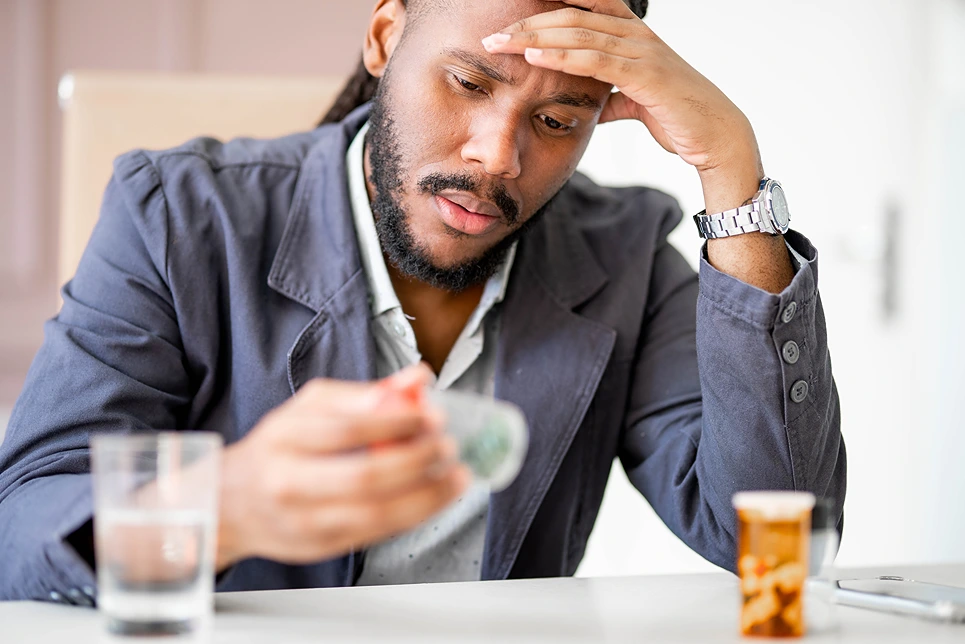Relieve Migraines and Headaches Through Properly Managed Hormone Levels
Testosterone replacement therapy (TRT) has become a popular treatment option for men experiencing low testosterone (low T). However, some men report developing headaches after starting TRT. What causes these headaches with testosterone therapy and how can you alleviate them?
At Physician’s Rejuvenation Centers, we recognize that optimizing hormone levels is complex. Our expert medical team can help manage your TRT protocol to minimize side effects like headaches.
Read on to learn more about how TRT can be related to headaches, as well as tips on reducing headache frequency and severity while on testosterone therapy.
Understanding Testosterone Replacement: Who Needs It and Why

Testosterone replacement therapy (TRT) is a treatment that helps raise testosterone levels in men back to normal ranges. Testosterone is an important male hormone that declines with age. TRT can effectively treat low testosterone symptoms like low energy, decreased muscle mass, mood changes, and reduced sex drive.
Starting testosterone replacement therapy can be life-changing, but some men may experience headaches. We’ll explore why this happens and what you can do to find relief.
Discover if TRT is right for you. Schedule a consultation with our knowledgeable medical professionals at Physician’s Rejuvenation Centers
Preventing Headaches Before Starting TRT
Headaches are a potential side effect of testosterone replacement therapy (TRT) for some men. However, there are proactive steps you can take before starting TRT to potentially reduce your susceptibility:
Minimize Common Triggers
- Chronic stress can contribute to headaches. Consider relaxation techniques like meditation, yoga, or deep breathing exercises to manage stress levels.
- Aim for 7-8 hours of quality sleep each night. Develop a consistent sleep schedule and create a relaxing bedtime routine.
- Dehydration can be a headache trigger. Ensure you’re drinking plenty of water throughout the day.
- Pay attention to your diet and identify any potential food triggers for headaches such as caffeine, MSG, or artificial sweeteners. Consider keeping a food diary to track your intake and identify potential culprits.
- While some people rely on caffeine to manage headaches, excessive consumption can actually trigger them. Monitor your caffeine intake and aim for moderation.
Nutritional Support
- Studies suggest magnesium deficiency might be linked to headaches. Consider incorporating magnesium-rich foods like dark leafy greens, nuts, seeds, and whole grains into your diet.
- B vitamins play a role in nerve function and some studies suggest they might be helpful in preventing headaches. This antioxidant might offer some benefit in reducing headache frequency, though further research is needed.
Why Testosterone Replacement Therapy Potentially Causes Headaches
Fluctuating hormone levels can sometimes trigger headaches in those prone to migraines. The changes in testosterone levels from beginning TRT can cause headaches for some men.
Likewise, when stopping TRT, testosterone levels will drop. This reduction can also cause withdrawal headaches as the body adjusts.
That said, research indicates headaches from TRT are generally mild and often resolve on their own within days or weeks as the body adapts to the new testosterone levels. Severe or persistent headaches may signal the need for medication adjustments to better stabilize hormones.
Types of Headaches Caused by Testosterone Therapy
There are several types of headaches that may occur with TRT:
Migraines
Also called vascular headaches, migraines can cause severe pulsating pain on one or both sides of the head. Migraine attacks often include other symptoms like nausea, vomiting, and sensitivity to light and sound.
Hormonal fluctuations are a common migraine trigger for both men and women. The changes in testosterone levels from TRT can sometimes bring on migraines or exacerbate existing migraines. This tends to improve after hormone levels stabilize.
Tension Headaches
Tension headaches involve moderate pain felt on both sides of the head. They may feel like tightness or pressure, unlike the throbbing pain of migraines.
Some men report tension headaches when stopping TRT and experiencing testosterone withdrawal. Dehydration from TRT can also cause tension headaches.
Cluster Headaches
Cluster headaches occur in cycles (clusters) and affect one side of the head at a time. They are characterized by severe burning or piercing pain around or behind one eye.
Research suggests that an abnormally high or low testosterone level may trigger cluster headaches in those prone to them. However, testosterone therapy has also been shown to help some men with refractory cluster headaches.
High Blood Pressure Headaches
Testosterone can elevate blood pressure in some men, particularly when first starting therapy. High blood pressure is a risk factor for headaches.
Monitoring blood pressure and maintaining levels in the healthy range can help minimize headaches from high blood pressure while on TRT.
Find relief from migraines, tension headaches, and more with tailored treatment plans from the experienced professionals at Physician’s Rejuvenation Centers
Why Do I Get Pressure Headaches From Testosterone Therapy?

If you are experiencing pressure headaches from testosterone replacement therapy, there are a few potential reasons why:
| Possible Cause | Description |
| Blood Pressure Changes | Testosterone can increase blood pressure temporarily when levels rise rapidly. This can trigger pressure headaches. |
| Hormone Fluctuations | At the onset of TRT, testosterone levels fluctuate until they stabilize. These hormonal changes can cause headaches. |
| Estrogen Conversion | Some testosterone converts to estrogen in the body. Excessive aromatization can elevate estrogen levels and lead to estrogen-triggered headaches. |
| Dehydration | TRT speeds metabolism and increases sweating, which can result in mild dehydration and trigger tension and pressure headaches. |
How to Manage Migraines After Starting Testosterone Therapy
If you develop migraines or your existing migraines worsen after beginning testosterone replacement therapy, don’t suffer in silence. There are ways to help control TRT-related migraines:
1. Track Your Hormone Levels
Monitoring your testosterone levels can help identify fluctuations that trigger your migraines. Your doctor may adjust your TRT dose to stabilize levels.
2. Consider Continuous Therapy
Subcutaneous testosterone implants or pellets that release hormones steadily may prevent migraines from hormonal ups and downs.
3. Use Acute Migraine Medications
Over-the-counter NSAIDs like ibuprofen can relieve migraine pain when attacks occur. Your doctor may also prescribe triptans or other migraine drugs.
4. Make Lifestyle Changes
Improving sleep, reducing stress, staying hydrated, and limiting migraine dietary triggers can all help lower migraine frequency and severity.
5. Keep a Headache Diary
Note headache patterns, severity, triggers, and medication effects. Bring this log to doctor visits to inform treatment adjustments.
Be patient as it may take some trial and error under medical supervision to find the ideal testosterone therapy protocol and migraine management approach for your needs.
Can Reducing Testosterone Dosage Reduce Headaches?
Decreasing testosterone dosage under the doctor’s supervision may help reduce headaches from testosterone replacement therapy.
When stopping TRT suddenly, testosterone levels drop rapidly. This can actually cause headaches from testosterone withdrawal. Tapering testosterone dosage slowly can minimize these withdrawal symptoms.
Likewise, if testosterone levels are peaking too high, this may exacerbate headaches in some men. Lowering the TRT dose can prevent spikes in testosterone that trigger headaches.
Finding the lowest effective testosterone dosage helps many men minimize TRT side effects, including headaches. Your doctor will work with you to determine optimal testosterone dosing based on lab work, symptom monitoring, and treatment goals.
It’s important not to adjust your TRT protocol on your own. Always consult your healthcare provider before making any changes to therapy.
Explore the possibility of reducing headaches with optimized testosterone dosing under our expert care
Partner With Physician’s Rejuvenation Centers for Improved Health and Vitality

At Physician’s Rejuvenation Centers, we recognize testosterone replacement therapy affects every man differently. What works well for one patient may cause side effects like headaches for another.
Our experienced medical team offers personalized care to help you feel your best on hormone replacement therapy. We’ll partner with you for optimal TRT dosing, headache prevention, and overall wellness.Discover a new level of health and vitality. Schedule a consultation with Physician’s Rejuvenation Centers today. Our experts are here to guide you toward effective testosterone therapy with minimal side effects. Invest in yourself and your well-being.

